Click on images to enlarge
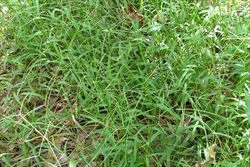
infestation (Photo: Sheldon Navie)
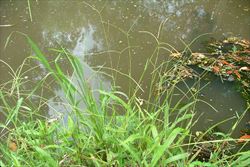
habit (Photo: Sheldon Navie)
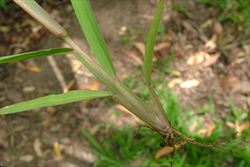
roots, stem and lower leaves (Photo: Sheldon Navie)
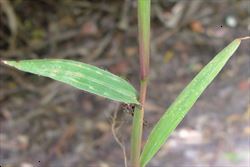
close-up of stem and leaf blade (Photo: Sheldon Navie)
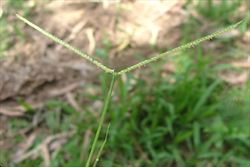
seed-head (Photo: Sheldon Navie)
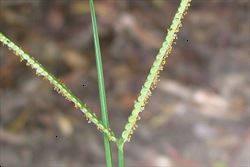
close-up of flower spikelets (Photo: Sheldon Navie)

close-up of seeds (Photo: Steve Hurst at USDA PLANTS Database)
Scientific Name
Paspalum conjugatum P.J. Bergius
Family
Gramineae (South Australia)Poaceae (Queensland, New South Wales, the ACT, Victoria, Tasmania, Western Australia and the Northern Territory)
Common Names
buffalo grass, carabao grass, cow grass, Hilo grass, Hilograss, Johnston River grass, paspalum grass, sour grass, sour paspalum, sourgrass, T grass, t-grass, Thurston grass, ti grass, yellow grass
Origin
This species is thought to have originated in tropical America, but is now found throughout the tropical regions of the world (i.e. it is pan-tropical).
Naturalised Distribution
Widely naturalised in northern and eastern Australia (i.e. in northern Western Australia, in some parts of the Northern Territory, in northern and eastern Queensland and in the coastal districts of northern New South Wales). Also naturalised on Christmas Island.
Naturalised overseas in tropical and northern Africa, tropical Asia (e.g. Cambodia, China, Brunei, Malaysia, Singapore, Taiwan, Indonesia, the Philippines, Thailand, Vietnam and Papua New Guinea), Mauritius, the Seychelles and numerous Pacific islands (i.e. American Samoa, Western Samoa, the Cook Islands, the Galápagos Islands, Micronesia, Fiji, French Polynesia, Guam, the Marshall Islands, New Caledonia, Niue, Palau, the Solomon Islands and Hawaii).
Notes
Sourgrass (Paspalum conjugatum) is regarded as an environmental weed in Queensland, Western Australia and New South Wales. It prefers wetter habitats and is a serious weed of plantation crops (e.g. sugarcane), orchards, vineyards, irrigation channels, parks, lawns, roadsides, disturbed sites, waste areas and pastures in northern Australia. It also invades natural vegetation such as rainforest gaps and margins, watercourses and riparian areas.

